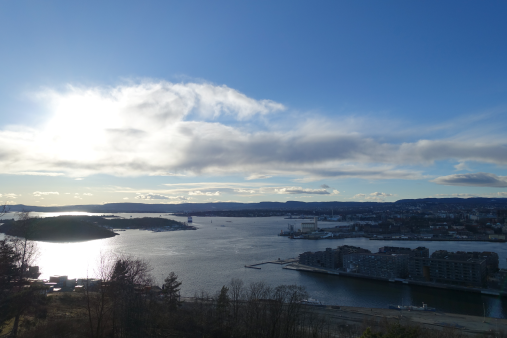“The Scream” has become one of the most iconic pieces of art in the world. What kind of weather phenomenon did Munch see and paint in this painting with this colorful red skyline over the Oslo fjord?
One hypothesis was put forward by three American astronomers in 2004 that the red sky was due to volcanic dust in the atmosphere after the eruption of Krakatoa in 1883 (Olsen, et al., 2004). This hypothesis is now challenged in a new Norwegian study.
Krakatau: Volcanic island in Indonesia which had a deadly outbreak in 1883, at least 36,417 were killed. Caused the release of large amounts of CO2 to the atmosphere, yielding lower global temperatures.
Mother-of-pearl clouds: Formed high in the stratosphere in winter at high southern and northern latitudes. The sun's rays hit horizontally under the clouds before sunrise or after sunset, and is broken in the ice crystals and provides brilliant colors.
Source: Wikipedia
Obviously a one-time experience
– We found this hypothesis not to be credible; as such reddish sunsets should have been quite common for a few years after the eruption. For Munch it is obvious that his vision was a one-time experience. Therefore, another explanation must be sought, Fikke and Nordli says, two of the authors of the article.
They found that mother-of-pearl clouds are a more likely phenomenon inspiring Munch’s painting.
Such clouds appear with very irregular intervals in the winter stratosphere at high latitudes, about 20-30 km above the Earth’s surface.
They may be brilliant in both colors and intensity and remain visible a while after sunset. These polar stratospheric clouds are very unlike ‘regular’ clouds in the lower troposphere. Observations of such clouds were reported during the last decades of the 19th Century.

Such clouds are occasionally seen in the Oslo area these days, and made a particularly spectacular display after sunset 22 of December 2014, as documented in the photo above by the authors.
New hypothesis presented for the first time
The new study will be presented by Dr Helene Muri, UiO, on behalf of the authors, at the European Geosciences Union (EGU) General Assembly on 24 April, in Vienna.
The large General Assembly congress brings together thousands of European scientists and interested in earth science, and the new study has been selected to be presented at a press conference during the congress.
Muri presents the study specifically on behalf of Professor Jón Egill Kristjánsson, Department of Geosciences, one of the authors of the article. Kristjánsson died in a tragic climbing accident right after the article was accepted for publishing in the scientific journal 'Weather'. Muri is a meteorologist and researcher at the Department of Geosciences, University of Oslo.

Several versions of 'The Scream'
Munch painted The Scream several times, and the version that the scientists use in their article that best reproduces the polar stratospheric clouds is the version he probably painted in 1910. This version is exhibited in the Munch Museum in Oslo.
In the National Gallery, Oslo hangs an even earlier version of The Scream, this dated 1893. A favorite destination for many tourists and others who want to see Munch's many iconic works. Here in the big showroom are several of them exhibited.
The National Gallery's version of 'The Scream' became world famous overnight after this painting was stolen in 1994, but fortunately came back to the National Gallery.
Reference to the article in Weather:
Fikke, SM., Kristjánsson, JE., & Ø., Nordli. 2017. Screaming clouds. Weather, Wiley, DOI: 10.1002/wea.2786
About The Scream:
The Scream, National Gallery, Oslo. Edvard Munch, The Scream, 1893
